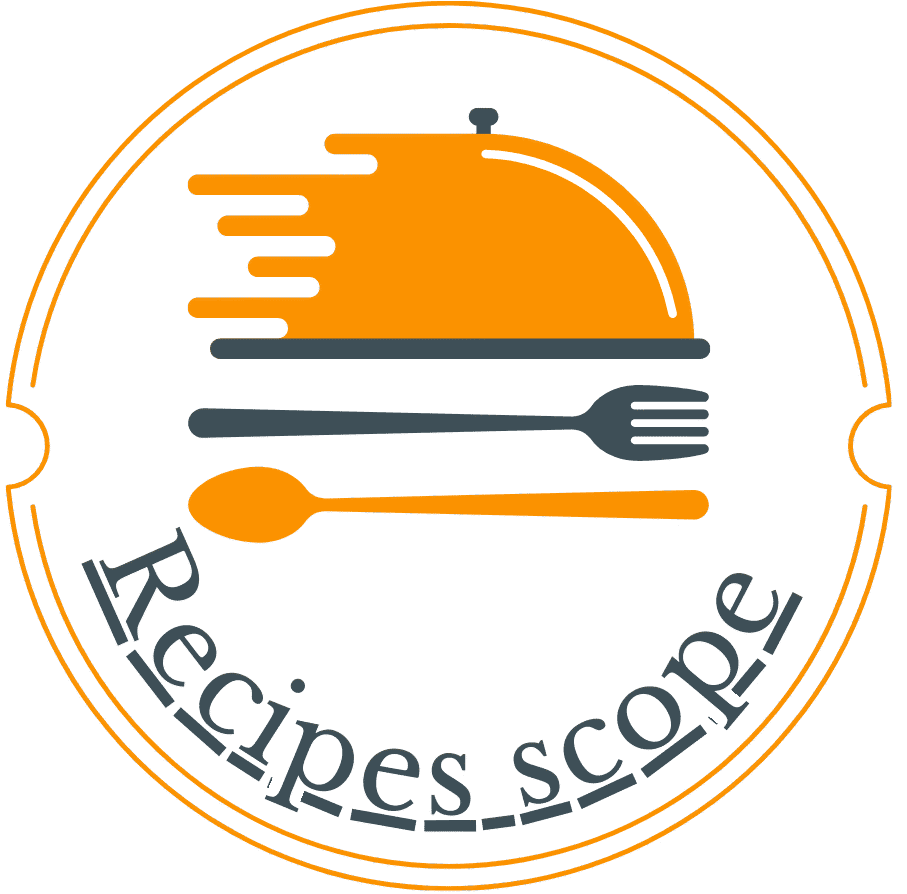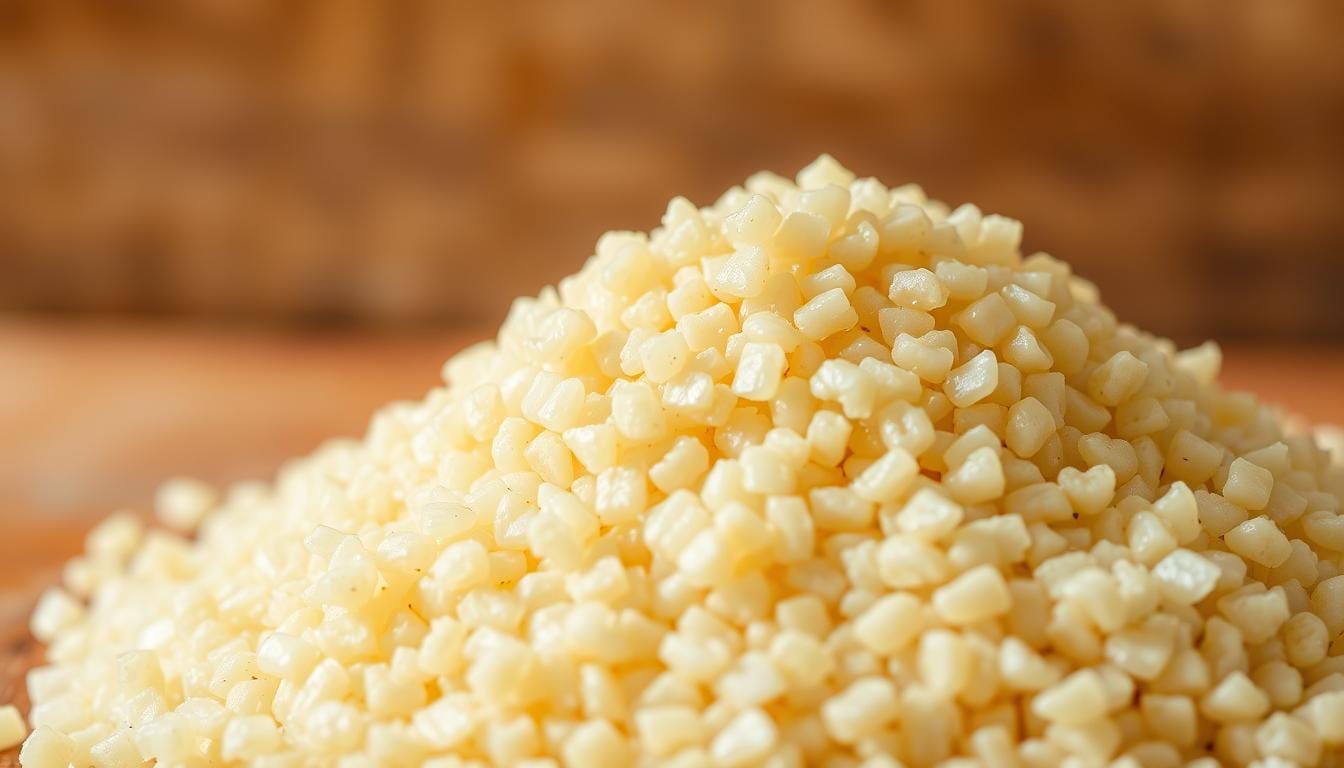Imagine turning a simple meal into something amazing with just one ingredient. Couscous is that ingredient—a versatile grain that fits any flavor or style. It’s perfect for any event, from a cozy family dinner to a party with friends.
This special pasta, made from semolina flour and water, can make your dishes stand out. Learning about couscous opens up its rich history and health benefits. Every dish becomes not just tasty but also nutritious.
Explore the world of couscous and see how it can inspire your next delicious meal.
Key Takeaways
- Couscous is made from semolina flour and water, categorizing it as a type of pasta.
- This ingredient is known for its adaptability, complementing various dishes and flavors.
- Couscous provides an easy way to create healthy and delicious meals.
- Exploring the different varieties of couscous adds excitement to your cooking.
- The health benefits of couscous include being rich in nutrients and fiber.
What is Couscous?
Couscous is a dish loved in many cultures, mainly in the Mediterranean and North Africa. It’s known for its unique texture and can go with many flavors. This makes couscous a key ingredient in various meals.
Couscous Origins and History
Couscous has been around for about 2,000 years in Northwest Africa. It’s a big part of North African cuisine and Berber culture. Traditionally, it was made by hand with semolina flour and water, creating small, fluffy grains.
This traditional method is kept alive by passing it down through generations. It keeps the dish’s authenticity and cultural value.
How Couscous is Made
Making couscous shows why it’s so versatile and loved. It starts with mixing semolina flour with water to form small grains. These grains are then steamed until they’re fluffy and tender.
Recently, instant couscous has become popular in the US. It’s easy to make with just boiling water and a short wait. This dish’s rich couscous history and the way it’s made make it a favorite around the world.
| Aspect | Traditional Couscous | Instant Couscous |
|---|---|---|
| Preparation Time | 1-2 hours | 5-10 minutes |
| Cooking Method | Steamed in couscousière | Boiled water and resting |
| Taste and Texture | Authentic, fluffy | Quick, soft |
| Culinary Uses | Traditional dishes | Quick meals, salads |
Types of Couscous to Explore
Exploring different types of couscous is a fun culinary adventure. Each type has its own texture and flavor, making it great for many dishes. Here are three main types of couscous you should try.
Moroccan Couscous
Moroccan couscous is the most common and has fine granules. It cooks in about five minutes and soaks up flavors well. It’s a staple in North African cooking, often served with stews or veggies.
Lebanese Couscous
Lebanese couscous is the largest and has a bold texture. It’s great in hearty stews because it holds flavors well. It takes longer to cook, but it’s a hit at gatherings.
Health Benefits of Couscous
Couscous is more than just a tasty addition to your meals. It’s also good for your health. This versatile grain is full of nutrients that can improve your well-being.
Rich in Nutrients
Couscous is a nutritious choice, packed with vitamins and minerals. Adding it to your diet means you get to enjoy its nutrient-rich profile. An 80g serving has about 142 calories, making it a good choice for balanced meals.
High in Selenium and Plant-Based Protein
Couscous is known for its selenium content. Selenium is important for thyroid function and has antioxidant benefits. It also has plant-based protein, which is key for muscle repair and growth. This makes it great for vegetarians and vegans who need protein.
Source of Fiber for Digestive Health
The fiber in couscous helps with digestive health. It promotes regular bowel movements and prevents constipation. Whole wheat couscous has even more fiber, helping keep you energized and your digestion stable. Eating couscous helps you maintain a balanced diet and supports your overall health.
How to Cook Couscous Perfectly
Couscous is a versatile grain that can be prepared in various ways. It’s perfect for many meals. Knowing how to cook couscous well is key, whether you use instant or traditional methods. Here are the steps to cook couscous perfectly.
Instant Couscous Cooking Instructions
Cooking couscous doesn’t have to take long. For instant couscous, just follow these easy steps:
- Bring your choice of liquid (water, broth, or a mix) to a boil.
- Add the couscous to the boiling liquid and stir briefly.
- Remove the pot from heat, cover tightly, and let it sit for 5 minutes.
- Fluff with a fork before serving to ensure light and airy grains.
Traditional Couscous Preparation Techniques
For a more authentic taste and texture, try traditional couscous preparation. This method involves steaming couscous over simmering broth or stew in a couscousière:
- Soak the couscous in water for about 30 minutes to hydrate.
- Transfer the soaked couscous to the top compartment of the couscousière.
- Steam over simmering liquid for approximately 30 minutes, stirring occasionally.
- Remove from heat and allow to rest before fluffing.
Fluffing Couscous for Optimal Texture
To get the best texture, fluffing couscous is key. Do this while the couscous is warm:
Using a fork to fluff the couscous will break up clumps and allow steam to escape, resulting in a light and fluffy dish.
Couscous Salad Ideas
Couscous salads are a great way to mix flavors and textures. They make any meal more enjoyable. You can try many different combinations, each one unique. Couscous absorbs flavors well, making your dishes taste better.
Fresh and Flavorful Ingredient Combinations
Think about using bright ingredients for your couscous salads. Colorful veggies and herbs are a great choice. Here are some tasty options:
- Cherry tomatoes, cucumbers, feta, parsley, and olive oil
- Bell peppers, red onion, olives, and lemon juice
- Avocado, corn, cilantro, and chili powder
These mixes add variety and keep things light and healthy.
Warm Couscous Salads with Roasted Veggies
On cooler days, warm couscous salads offer comfort and nutrition. Roasting veggies enhances their sweetness, making them great with couscous. Consider these ingredients:
- Roasted zucchini, eggplant, and bell peppers with chickpeas
- Sweet potatoes and Brussels sprouts with nuts and vinaigrette
- Caramelized onions, mushrooms, and frozen peas
These warm salads are filling and can be main dishes or sides. Couscous’s texture makes it a great base for satisfying meals.
Healthy Couscous Dishes You Should Try
Exploring healthy couscous dishes opens up a world of flavor and nutrition. Couscous is a great base for meals, allowing for creativity and enjoyment while keeping calories low. You can find low-calorie couscous recipes that fit different tastes and diets. Here are two exciting ways to enjoy this versatile grain.
Low-Calorie Couscous Recipes
One tasty option is couscous-stuffed bell peppers. Mix couscous with veggies and a light protein like chicken or legumes for a colorful dish. Another choice is a vibrant grain bowl with fresh veggies, herbs, and tahini dressing. These recipes are satisfying without being heavy.
Couscous as a Side Dish
Couscous is also great as a side dish. It pairs well with grilled meats, fish, or as a base for stews. Its ability to enhance flavors makes it a top choice for sides. Try couscous with fresh herbs or roasted veggies for taste and texture without extra calories.
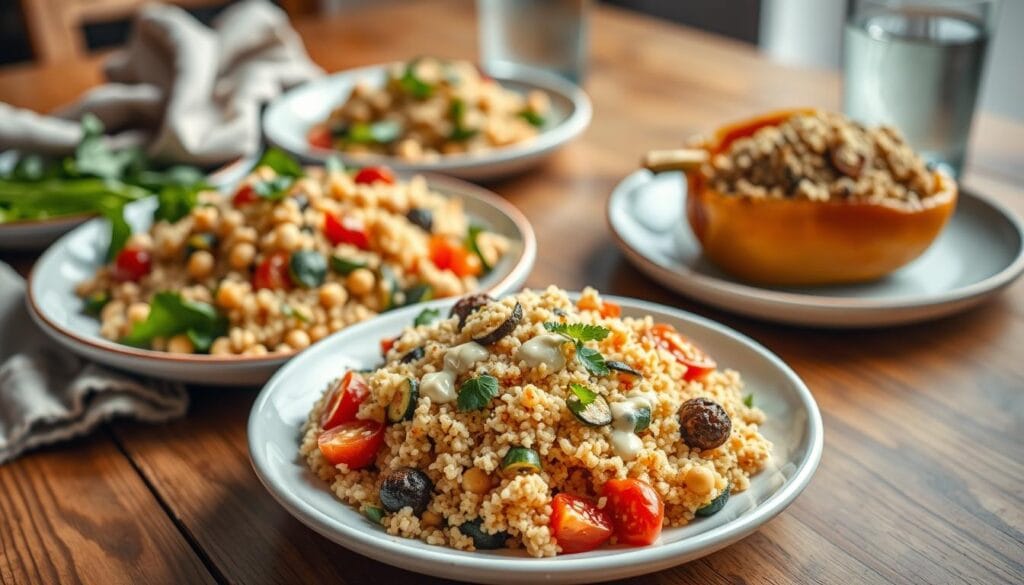
Nutritional Profile of Couscous
Couscous is packed with nutrients, making it a great choice for a healthy diet. Knowing what’s in couscous helps us see how it fits into a balanced meal plan. It’s full of good stuff, like proteins and vitamins, that are essential for our bodies.
Caloric Content and Macronutrients
A cooked serving of couscous (80g) has about 142 calories. Most of these calories come from carbs. It also has 5.8g of protein and 30g of carbs, which is good for energy.
Choosing whole wheat couscous boosts the protein and fiber. This makes it even more nutritious for our meals.
Vitamins and Minerals in Couscous
Couscous is more than just calories; it’s also rich in vitamins and minerals. It has potassium, phosphorus, and selenium. These minerals help keep our bodies working right, from keeping electrolytes balanced to supporting bone health.
Adding couscous to our meals lets us get these important nutrients.
| Nutrient | Amount per 80g Serving |
|---|---|
| Calories | 142 kcal |
| Protein | 5.8 g |
| Carbohydrates | 30 g |
| Potassium | 100 mg |
| Phosphorus | 40 mg |
| Selenium | 15 mcg |
The Best Couscous Brands to Consider
Choosing the right couscous brand is key to a great meal. Look for brands that use the finest durum wheat. Also, find brands that offer whole wheat couscous for a healthier option.
Quality and Sourcing of Ingredients
Check where the ingredients come from when picking couscous. High-quality durum wheat makes couscous tasty and healthy. Choose brands that process minimally and avoid additives. Good couscous is perfect for salads, stews, and more.
Popular Brands Available in the U.S.
In the U.S., Near East and Bob’s Red Mill are top choices. Near East is loved for its consistent taste and texture. Bob’s Red Mill offers whole grain options and unique flavors. Both brands ensure your couscous is top-notch.
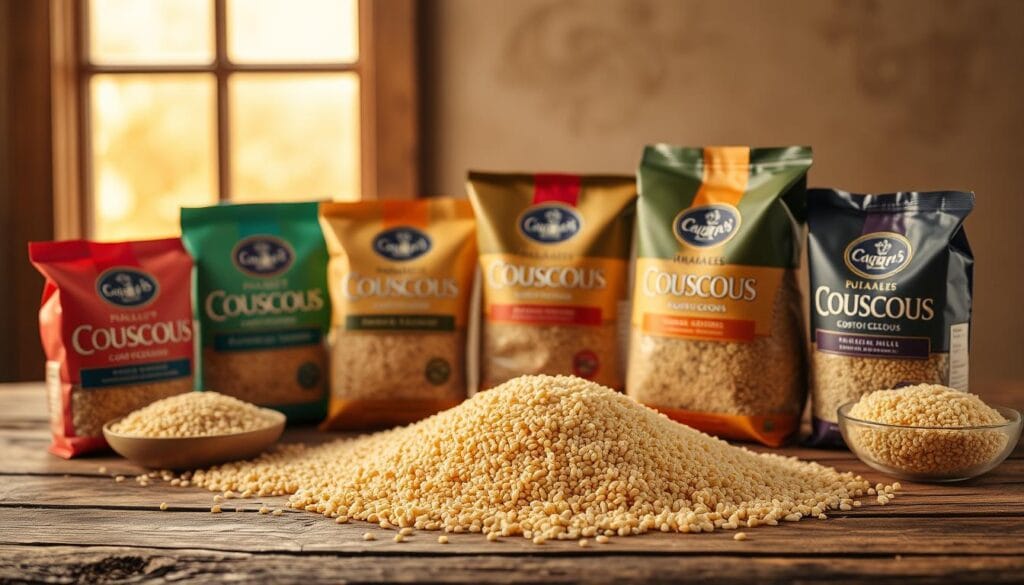
Couscous vs. Other Grains
Couscous is a standout grain, often compared to rice and quinoa. Each grain has its own qualities and benefits. This makes it easy to pick the right one for your diet and taste.
The comparison of couscous shows its quick cooking time and nutritional value. This helps you see how these grains can be part of your meals.
Couscous vs. Rice
Couscous cooks faster than rice, needing only boiling water and a quick steam. Rice, on the other hand, takes longer to cook. This is a big plus for couscous when you’re short on time.
Also, couscous has more protein and nutrients than white rice. This makes couscous a great choice for those looking to boost their meals without spending hours in the kitchen.
Couscous vs. Quinoa
The debate between couscous and quinoa focuses on protein and flavor. Quinoa is a complete protein, perfect for vegetarians and vegans. Couscous, on the other hand, is great at soaking up flavors, making it versatile in many dishes.
Both grains offer unique benefits. They can be part of a balanced diet, allowing you to enjoy their differences.
Moroccan Couscous Variations
Moroccan couscous dishes show a rich culinary tradition. Couscous is the star, often mixed with spices and vegetables. It’s a key part of many meals, like in tagines filled with meat, fish, or veggies.
Traditional Moroccan Dishes Featuring Couscous
Traditional dishes like couscous with seven vegetables and lamb tagine highlight Moroccan cuisine. They use unique spices and fresh ingredients. This gives them a special taste.
Couscous in International Cuisine
Couscous is loved worldwide, not just in Morocco. In Mediterranean cooking, it’s paired with grilled seafood and herbs. It’s also great in grain bowls or salads, celebrating fresh ingredients.
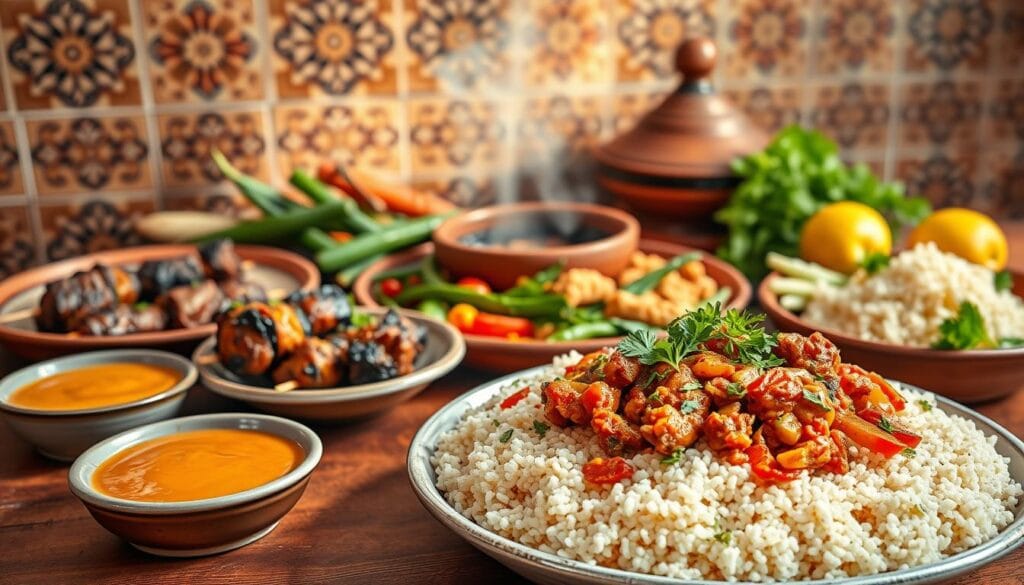
Is Couscous Gluten-Free?
Couscous comes from durum wheat and is not gluten-free. This is a problem for those with gluten sensitivity or celiac disease. There are alternatives that let you enjoy similar dishes without gluten.
Identifying Gluten-Free Options
Look for gluten-free couscous made from rice, corn, or cassava. Some brands offer gluten-free couscous that looks and feels like the real thing. Always read labels to avoid hidden gluten.
Alternatives for Gluten Sensitivity
For gluten sensitivity, try millet or sorghum. These grains can be used like couscous and add variety to your meals. They’re great for those who can’t have gluten.
| Grain | Gluten Content | Common Uses |
|---|---|---|
| Couscous | Contains gluten | Salads, sides, and main dishes |
| Gluten-Free Couscous (Rice-based) | Gluten-free | Salads, sides, and main dishes |
| Millet | Gluten-free | Porridge, salads, pilafs |
| Sorghum | Gluten-free | Salads, soups, baking |
Conclusion
Couscous is a standout in the world of food, blending versatility with rich flavors. It’s a simple yet powerful ingredient for making your meals special. It’s great for a wide range of dishes, meeting different tastes and dietary needs.
Preparing couscous is easy, and it comes in many types. Each one brings its own taste and texture to your dishes.
The benefits of couscous go beyond its taste. It’s packed with nutrients, vitamins, and minerals. It’s also a good source of plant-based protein and fiber. Adding couscous to your meals boosts your health and makes your food more exciting.
In short, couscous is perfect for both simple salads and traditional Moroccan dishes. It’s a must-have in your kitchen. Let couscous take your cooking on a journey of flavors and textures.
